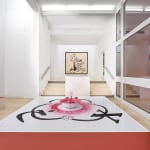Slavs and Tatars
Reverse Joy (Kha), 2012
MDF tile, water pump, pigmented water, bowl, spray paint
60 x 241 x 241 cm
23 9/16 x 94 14/16 x 94 14/16 in
23 9/16 x 94 14/16 x 94 14/16 in
Throughout their oeuvre, Slavs and Tatars often use the term ‘metaphysical splits’ to refer to the combination or collision of two mutually exclusive or antithetical ideologies, registers, concepts within one...
Throughout their oeuvre, Slavs and Tatars often use the term ‘metaphysical splits’ to refer to the combination or collision of two mutually exclusive or antithetical ideologies, registers, concepts within one page or space. No work perhaps better captures this idea of coincidentia oppositorum than Reverse Joy. Through the very simple gesture of a red pigment, the fountain brings together two ends of the spectrum: the innocent with the cynical, the naïve with the violent, through a single color red, for some a festive symbol recalling compote or kool aid, and for others the trace of blood, of martyrdom. Here, three iterations – in Hebrew, Cyrillic and Arabic alphabets – of the phoneme [kh] dance ceremoniously around the red fountain.
Exhibitions
2020, Villa Arson, Nice (FR)2017, Salt Galata, Istanbul (TR)
2015, Kraupa–Tuskany Zeidler, Berlin (DE)
amongst others
Literature
Work Cycle | Language ArtsThe march of alphabets has often accompanied the ascension and fall of empires and religions. In Language Arts, the collective unteases the politics of alphabets: the many fraught, often forgotten yet palpable attempts by nations, cultures and ideologies to ascribe a specific letter to a sound. The book Khhhhhhh (Moravian Gallery, Mousse / 2012) examines, literally, the throat as a space of phonetic and sacred agency via the Hebrew, Russian and Arabic letters for the fricative [kh] while Naughty Nasals looks to the nose, as a site of resistance in the Slavic and Turkic languages’.
Throughout their oeuvre, Slavs and Tatars often use the term ‘metaphysical splits’ to refer to the combination or collision of two mutually exclusive or antithetical ideologies, registers, concepts within one page or space. No work perhaps better captures this idea of coincidentia oppositorum than Reverse Joy. Through the very simple gesture of a red pigment, the fountain brings together two ends of the spectrum: the innocent with the cynical, the naïve with the violent, through a single color red, for some a festive symbol recalling compote or kool aid, and for others the trace of blood, of martyrdom. Here, three iterations – in Hebrew, Cyrillic and Arabic alphabets – of the phoneme [kh] dance ceremoniously around the red fountain.




